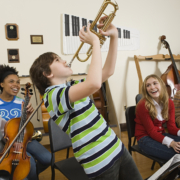Helping Students Discover Autonomy in the Classroom
In a world where traditional curricular pedagogies often dictate the rhythm of learning, it’s crucial for educators like you to consider the significant role of student autonomy. This blog delves into various film narratives to uncover how autonomy, or the lack thereof, shapes students’ learning experiences.
From the energetic classrooms of “School of Rock” to the challenging corridors of “Mean Girls,” each film offers a unique lens through which we can understand the intricacies of education. As teachers, your role isn’t just to impart knowledge; it’s to be the catalysts who ignite a passion for learning, foster individual thought, and encourage students to carve their own educational paths.
Let’s explore how these films can inspire you to embrace and enhance autonomy in the classroom.
“School of Rock” — Embracing Individuality
“School of Rock” showcases the transformational power of education when it steps beyond conventional bounds. In this film, you’ll see the rigid, traditional curriculum challenged by an unconventional teacher who brings out the best in his students through music and creativity. This narrative serves as a reminder for you, as educators, to recognize and harness each student’s unique talents. It encourages stepping out of standard frameworks to foster an inclusive learning environment where students can express themselves and learn through passion, thereby gaining confidence and a sense of identity.
Lesson: Allow students to express their individual talents.
Actionable Tip: Integrate project-based learning where students can choose topics or activities that resonate with their interests. This approach, as seen in “The School of Rock,” encourages students to take ownership of their learning and develop their unique strengths.
“Mean Girls” — Understanding Social Dynamics
“Mean Girls” offers a poignant look at high school social dynamics and the struggle for identity within traditional schooling environments. The film illustrates the impact of peer influence on students’ behavior and self-perception. For teachers, this highlights the necessity of guiding students in navigating social challenges while maintaining their individuality. It also underscores the importance of creating a classroom culture that prioritizes respect and empathy, enabling students to feel safe to be themselves and think independently, thereby promoting a sense of autonomy in their social and educational development.
Lesson: Recognize the impact of social dynamics on student identity.
Actionable Tip: Create a classroom culture that values diversity and inclusion. Activities that promote empathy and understanding, like group discussions or role-playing, can help students appreciate different perspectives, akin to the experiences depicted in “Mean Girls.”
“Short Term 12” — Acknowledging Diverse Backgrounds
“Short Term 12” is a compelling film that showcases the effects of a system that fails to meet individual student needs. It portrays the struggles of youth in a foster care facility, reflecting on themes of emotional trauma and healing. This film can inspire teachers to adopt a more empathetic and understanding approach, recognizing the diverse backgrounds and challenges their students may face. It emphasizes the need for inclusivity and culturally responsive teaching that respects each student’s unique journey, thereby fostering a supportive environment conducive to learning and personal growth.
Lesson: Be mindful of students’ varied backgrounds and experiences.
Actionable Tip: Personalize learning experiences to accommodate different learning styles and backgrounds. This could involve differentiated instruction or offering various types of assessments, mirroring the adaptive approaches seen in “Short Term 12.”
“Freedom Writers” — Embrace Diverse Perspectives
“Freedom Writers” is an inspiring example of how a progressive curriculum that acknowledges diverse student experiences can create profound educational impacts. This film highlights the transformative power of personal storytelling in education, where students from varied backgrounds find their voice. It emphasizes the role of teachers in facilitating an environment where students feel heard and valued, encouraging them to share their stories and learn from each other. This approach not only enhances empathy and understanding among students but also promotes a sense of autonomy and agency in their learning process.
Lesson: Shared experience and a drive to understand personal stories are foundational in building trust, community, and mutual respect.
Actionable Tip: Taking a cue from “Freedom Writers,” invite students to share their personal stories. Assignments that allow the expression of their unique experiences foster an inclusive classroom, helping students appreciate diverse viewpoints and build empathy.
Practical Tips for Fostering Student Autonomy
Imagine a classroom where your students are not just passive recipients of knowledge but active agents in their learning journey. Here are eight student engagement strategies you can try to promote learner autonomy:
- Encourage Independent Thinking: Challenge your students to think critically and form their own opinions. This can be done through open-ended questions, debates, and projects that require them to research and present their viewpoints. For example, after watching a relevant film, ask students to discuss its themes and how they relate to their own experiences.
- Personalize Learning: Recognize that each student has unique interests and learning styles. Incorporate elements that cater to these differences, such as choice-based assignments or projects that allow them to explore topics they are passionate about. This approach mirrors the individual attention given to students in films like “Freedom Writers”.
- Promote Self-Reflection: Encourage students to reflect on their learning journey. This can be through journals, self-assessment tools, or discussions that help them understand their progress and areas for growth. Self-reflection is a key element in fostering autonomy and self-awareness.
- Create a Safe Learning Environment: Ensure your classroom is a safe space where all students feel valued and heard. This involves setting clear expectations for respect and empathy, much like the inclusive environment highlighted in “School of Rock”.
- Incorporate Real-World Problems: Engage students with real-world issues and problems. This not only makes learning more relevant but also empowers students to see the impact of their education beyond the classroom.
- Utilize Collaborative Learning: Foster collaborative learning opportunities where students can work together, share ideas, and learn from each other. This approach can enhance communication skills and promote a sense of community.
- Encourage Creative Expression: Allow students to express themselves creatively, whether through art, writing, or other forms. This can be inspired by the creative teaching methods seen in “School of Rock”.
- Be a Facilitator, Not Just a Teacher: Adopt a facilitative approach in your teaching, guiding students in their learning journey rather than dictating it. This mirrors the teacher roles seen in “Freedom Writers” and “Short Term 12”, where educators facilitate rather than control learning experiences.
The bottom line
The journey of fostering student autonomy can be both challenging and rewarding. Films like “School of Rock,” “Mean Girls,” “Short Term 12,” and “Freedom Writers” not only offer compelling narratives but also valuable lessons for educators. Remember, as a teacher, your role is pivotal in shaping an environment where students feel empowered to explore, express, and engage with their learning journey. By implementing these practical tips, you can create a classroom culture that celebrates individuality, encourages critical thinking, and nurtures a sense of autonomy. Embrace this role and witness the transformative impact it has on your students’ educational experiences.



